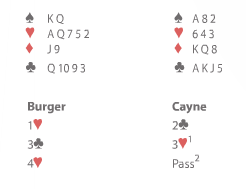Source: Bridge Canada April 2012
Slam bidding is an art. Many IMPs ( and matchpoints) can be generated by being consistently right in bidding and making slams. But it’s hard! A tiny slip will cause an 11 or 13 IMP loss. And Grand Slams are similar to what high rise construction workers have been known to say it is very scary at the top!’
It has even happened to me where we have bid a grand for -50 and our partners are defending against game! Once we lost 6 IMPs when we were in 7![]() down one and our opponents bid all the way up to 3
down one and our opponents bid all the way up to 3![]() !!
!!
Besides fortitude and sound partnership agreements there is a tremendous amount of judgment required to be a successful slam bidder. Some of the indicators to help you make the right judgments:
- A strong trump holding
- Source of tricks, either with extra trumps (55 fit or better) or a strong side suit.
- Controls
- No indication of bad splits, as with preemptive or two suited bidding by the opponents.
- Strength of holdings consistent with partner’s expectations.
However once you have gone through this analysis, there is one other factor to consider, and this is the number of key cards you hold. Despite a plethora of high cards if you are holding insufficient aces and trump honours you should be cautious in your invitations. This might not sound like an earth shaking tip. However there is a corollary that is less well known On fact I don’t recall seeing it in other bridge literature I have read):
On a slam Invitational auction, partner will take another call after a sign-off when he is rich In key cards, no matter what his strength.
So let’s go back to the original problem. You have:
- A very nice 15 HCPs
- Buffing values
- Five card trump support, with a guaranteed 10+ card fit.
But you have only two of the six key cards. Another way of looking at it: Do you think partner will sign off in MT with three aces? Or two aces with the trump king? No.
A local expert on the hand given, bid 4![]() . And partner, who could not have held a better hand, simply bid the slam with
. And partner, who could not have held a better hand, simply bid the slam with ![]() 4
4 ![]() K Q J
K Q J ![]() K 10 8 4 2
K 10 8 4 2 ![]() A Q J 5. Down one.
A Q J 5. Down one.
Here is another example, from the Bridge World Challenge the Champs. October, 1993.

Becker-Rubin effortlessly relayed to the best spot, 3NT. Zia – Rosenberg had this auction:

1 Reasonable choice, especially in their system
2 Relay, asking for shape.
3 3-6 shape in the majors, non forcing
4 Cue bid
5 Key Card
6 Two, no trump queen
7 In Challenge the Champs this will be not a good score
8 Here Zia got enamoured by his 15 FICK He neglected to ask himself two ‘Final Test’ ¨questions:
Can partner have what I need for his non forcing 3![]() ?’
?’
If partner actually held the ![]() Q,
Q, ![]() A K arid the
A K arid the ![]() A do I think he would actually pass had I signed off in 4
A do I think he would actually pass had I signed off in 4![]() or 4
or 4![]() , instead of bidding 4NT?
, instead of bidding 4NT?
One final example, with Jimmy Cayne successfully applying ‘the Final Test’

1 At least somewhat slammish
2 Cayne looked at 17 HPC and a known double fit and asked himself: ‘Would my partner simply sign off with a hand that can make slam such as:
He discovered the obvious correct answer»no» and made the right decision and passed 4![]() .
.
Lessons to Learn
When deciding whether or not to bid above the game level in a slam investigation auction, visualize the controls partner needs for slam to make, and ask yourself, If he held those cards would he have signed off in game on the actual auction?’
High cards are good, but you need sufficient controls to investigate and bid slams. In a game forcing auction a raise below game (such as the 3![]() bid in Example #3) is at least somewhat slamish.
bid in Example #3) is at least somewhat slamish.
